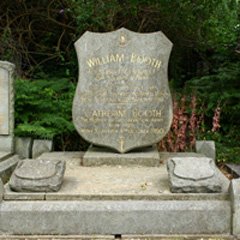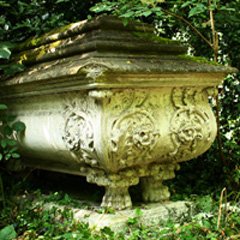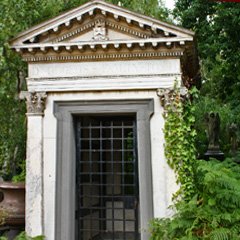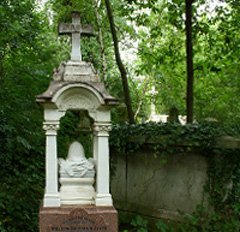
HERITAGE
History of Abney Park
In the early 1800s, London’s rapid population growth proved too much for inner city burial grounds, which were literally overflowing. Parliament passed a bill in 1832 to encourage the establishment of new private cemeteries. Within ten years, seven had been established (later dubbed 'The Magnificent Seven' by architectural historian Hugh Meller), one of which was Abney Park.
The site of Abney Park was formed from the estates of Fleetwood House and Abney House, the latter of which had been the home of renowned non-conformist and hymn writer Isaac Watts. This association quickly made Abney the foremost burial ground for Dissenters – those practising their religion outside the established church. It was founded on these principles, with a non-denominational chapel at its core, and was open to all, regardless of religious conviction.
Uniquely in London, Abney was also originally laid out as an arboretum, with 2,500 varieties of plants. An alphabetical planting of tree species was set out around the perimeter along with collections of oaks, thorns, pine and others within.
In the 1970s after the cemetery company went into administration, Abney fell into disrepair and was abandoned, allowing a uniquely wild atmosphere to develop at the site. The London Borough of Hackney took over ownership of the site in the 80s and started to manage it in partnership with the Abney Park Trust as lessee.
It was decided to maintain and manage this new and unique urban wilderness and today management aims to balance the needs of Abney's wildlife with the requirements of the historic landscape and structures as well as the Park's memorial role.
The Chapel
The first foundation stone of the chapel was laid by the Lord Mayor of London Sir Chapman Marshall on the 20th of May 1840, the day of the opening ceremony of Abney Park Cemetery.
The architect of the chapel was William Hosking FSA (1800 - 1861), a professor in architecture & civil engineering, and the first professor of architecture at Kings College. Hosking worked in conjunction with builder John Jay of London (interred in Abney Park on Dr Watts' Walk), and George Loddiges of Hackney, the renowned horticulturalist.
Central to the design of Abney Park, the chapel is the oldest surviving non-denominational chapel in Europe, and is the only surviving public building designed by Hosking, then considered a controversial architect. Hosking carefully planned the chapel to reflect a lack of bias towards any one Christian sect and the cruciform plan adopted the equal arms of the Greek cross, giving perceptual strength to the concept of equality before God.
The chapel is Gothic, with a single interdenominational cell and one covered horse and carriage entrance. It was not consecrated and functioned purely as a funerary chapel - not a place of worship. Hosking used London Yellow Stock brick for the exterior brickwork, as well as wrought Bath Stone facings. Romanesque and Neoclassical features modified his interpretation of the Gothic architectural styles so closely associated with forms of Christian worship. No tracery was used on the three-pointed gothic windows, representing careful consideration of design simplicity. Winding wooden staircases in the twin turrets provided access to a public galley above the porte-cochere and to the roof level. Standing at 120 feet, the steeple was the tallest in the district at that time. It is octagonal in cross-section and gains additional height from a raised octagonal base with a decorated rim. The unusual ten-part rose stained glass windows echoed the cemetery's rosarium, planted by famed horticulturalists, Loddiges, which contained over 1000 varieties of rose. Sadly the windows have been destroyed over the years by vandalism.
Vandalism and fire damage have resulted in the Grade II listed chapel being closed for many years and categorised as a building 'at risk' Category A by English Heritage. The chapel was hoarded off in October 2012 by Hackney Council as a safety measure.
The Trust is now working in partnership with Hackney Council, English Heritage and other organisations to raise funds to restore the chapel as the heart of Abney Park.
Famous residents
There are over 200,000 people laid to rest in Abney Park Cemetery, from world-famous names such as William Booth to relatively unsung heroes, such as Betsi Cadwaladr who, aged over 60, worked as a nurse alongside Florence Nightingale in the Crimea War. Here we touch upon the stories of just a few of the people for whom Abney is their final resting place.
Grave Stories: Narratives from the Abney Park archives
Abney’s Abolitionists
A number of key figures, who opposed abduction and enslavement and sought to establish various visions of a better world during the eighteenth and nineteenth century, are laid to rest in Abney Park Cemetery.
Alan Gartrell writes about Abney Park’s links to the first Anti-Slavery Convention in 1840.
Listed monuments
Samuel Robinson 1751 - 1833
An architect and surveyor, and founder of the Retreat Almshouses for the widows of dissenting ministers in Hackney. A white stone chest built in late gothic style, with detailed tracery patterning designed by Robinson.
John Swan 1787 - 1869
An engineer and inventor. The originator of the steamship's screw propellor (1824) and the self acting chain messenger (1831). He never patented his inventions, but allowed his superiors to publish them under their names. A draped and wreathed urn standing on a white stone pedestal.


























